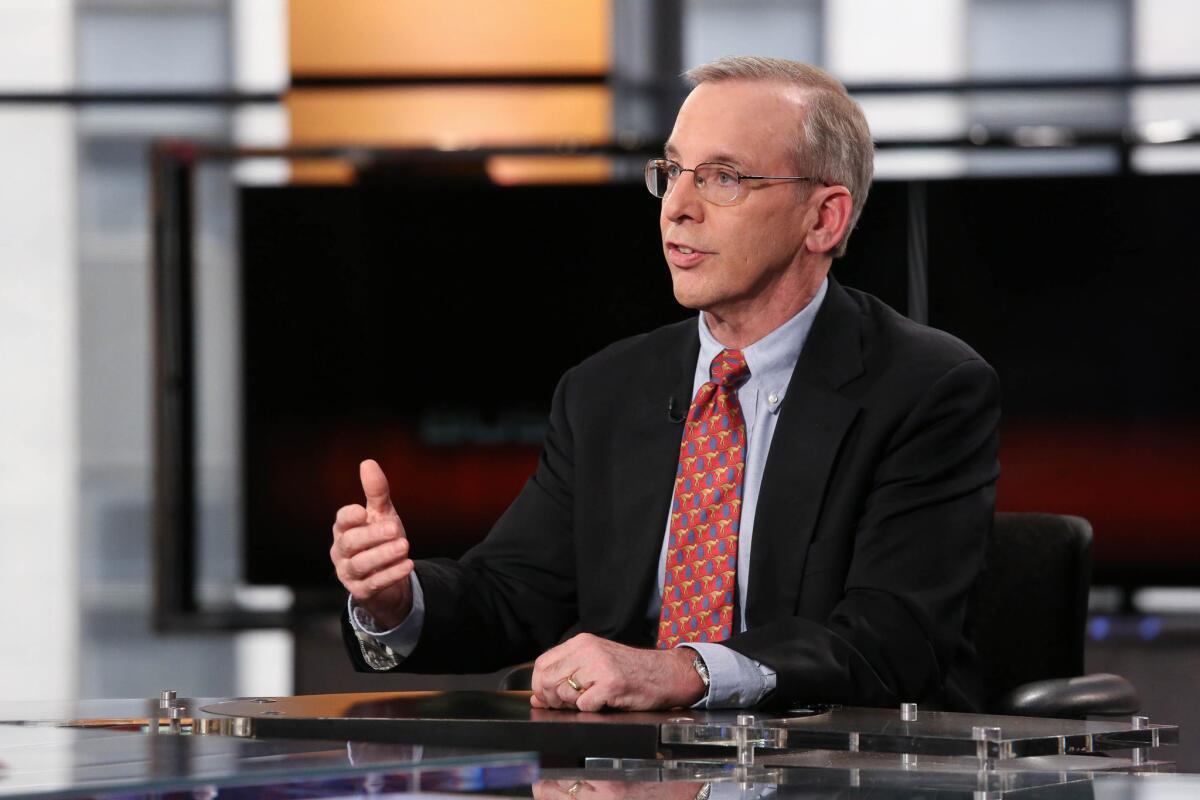With fewer households behind on bills, consumers better able to absorb economic shocks, Fed says

William C. Dudley, president of the Federal Reserve Bank of New York, appears on FOX Business Network in 2014.
- Share via
Reporting from Washington — The percentage of households behind on bills in the fourth quarter of last year dropped to its lowest level since 2007, making consumers more able to withstand financial shocks, according to government data released Friday.
The report on household debt and credit from the Federal Reserve Bank of New York showed consumers have made major strides in repairing their finances since the Great Recession.
That’s important as the U.S. economy faces new pressures from financial market turmoil and slowing global growth, said William C. Dudley, president of the New York Fed.
“The U.S. economy is in quite good shape,” he said. “There’s quite a bit of momentum in the U.S. economy to offset some of the weakness we’re going to see.”
Household debt rose a modest $51 billion from October through December to $12.1 trillion, fueled by an increase in auto debt.
But mortgage and home equity debt was down, reflecting caution after the trauma of the housing market collapse that helped trigger the recession.
Household debt peaked at $12.7 trillion in the third quarter of 2008, then declined over the next five years as consumers tried to repair their finances.
Although debt has increased about 8% since 2013, “this recent period of credit expansion looks very different from the early 2000s, and I believe that the household sector today is in much better health as a consequence,” Dudley said.
Consumers aren’t tapping rising home equity nearly as much as during the boom, Dudley said. That is keeping most households from getting overextended and falling behind on payments.
At the end of last year, 5.4% of household debt was delinquent, the lowest level since early 2007. And new foreclosures were at the lowest level since the Fed began tracking the data in 1999.
“This means that households have more capacity with which to absorb any temporary adverse income shock,” Dudley said.
Those shocks could be coming as major stock indexes are down sharply since the start of the year.
Dudley echoed congressional testimony this week by Fed Chairwoman Janet L. Yellen in saying central bank policymakers were watching conditions in financial markets and world economies to determine whether to raise a key interest rate next month.
“We’re not going to be definitive and say we’re absolutely not going to do X or we’re going to do Y because the data could change,” said Dudley, who is vice chairman of the Federal Open Market Committee, which makes the central bank’s monetary policy.
The Fed raised its benchmark short-term interest rate by 0.25 percentage point in December, the first increase in nearly a decade. The rate had been kept near zero for seven years to try to boost economic growth.
The rate remains extremely low -- the target is between 0.25% and 0.5% -- and Dudley said that limits how the Fed could respond to an economic downturn.
But he said it was “extraordinarily premature” to discuss the possibility the Fed would push the rate below zero as some central banks in Europe and Japan have done. The move is designed to encourage banks to lend excess reserves.
Pressed by lawmakers on the issue this week, Yellen said the Fed was studying the legality and implications of a negative rate.
Dudley said Friday it was “not something I’m spending a lot of time thinking about.”
There were “a lot of things we would do if things turned down before we got to negative interest rates,” he said.
Follow @JimPuzzanghera on Twitter
More to Read
Inside the business of entertainment
The Wide Shot brings you news, analysis and insights on everything from streaming wars to production — and what it all means for the future.
You may occasionally receive promotional content from the Los Angeles Times.











